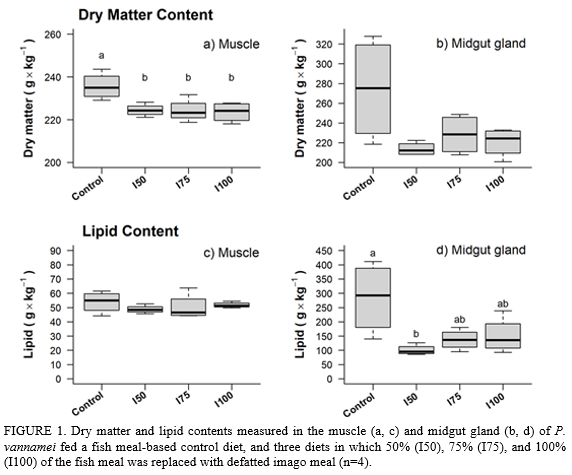ADULT BLACK SOLDIER FLIES (IMAGINES, Hermetia illucens) AS A REPLACEMENT FOR FISH MEAL IN DIETS FOR PACIFIC WHITELEG SHRIMP Penaeus vannamei
Introduction
Large-scale insect farming holds significant potential for transforming biogenic waste into high-value protein for use in animal feed and human food. The black soldier fly, Hermetia illucens, is one of the most cultured insects worldwide. Imagines, the adult life stage of the insect, are only cultivated for reproduction and are arising as novel and unused by-product of industrial black soldier fly larvae production (Soetemanns et al., 2020). Utilization of this side stream as feed ingredient for high value species like Penaeus vannamei would reduce waste, create by-product value, and promote a circular economy. In this work, an in-depth chemical analysis of meal prepared from the adult black soldier fly was made and the apparent digestibility of key nutrients was determined in vivo in P. vannamei. A consecutive growth trial was conducted to assess effects of replacing fish meal with imago meal on weight gain, feed utilization, digestive enzyme activities, and immunological parameters of P. vannamei.
Materials and methods
Dead adult black soldier flies were collected from a local insect farm, dried, and ground to homogenous meal (< 500 µm). Composition of gross nutrients, amino acids, fatty acids, selected minerals, chitin and, cholesterol were determined. Full-fat and partially defatted imago meals were used in a digestibility trial with juvenile P. vannamei, using a reference and test diet with yttrium as an inert marker. Based on these findings, experimental diets replacing 50% (I50), 75% (I75), and 100% (I100) of the fish meal content with defatted imago meal were formulated on digestible protein and energy levels. Experimental diets were used for an acceptability trial and a 40-day growth trial with juvenile shrimp (5.4 ± 1.0 g). At the end of the growth trial, digestive enzyme activities were measured in crude extracts made from shrimp midgut glands. Glucose, protein, total hemocyte counts, phenol-, and prophenoloxidase activities were measured in the hemolymph. Shrimp muscle and midgut glands were analyzed for dry matter, lipid, and protein content.
Results and discussion
Full fat imago meal contains 52% protein, 36% lipid, and moderate levels of chitin (5%). Considerable amounts of amino acids are present with an essential amino acid index of 1.8, referring to the ideal protein for penaeid shrimp (NRC, 2011). Cholesterol and copper were detected at moderate concentrations of 2.8 g·kg-1 and 16 mg·kg-1, respectively. Defatting the imago meal (IM) reduced the lipid content to 23% and increased protein levels to 60%. Results of the digestibility trial showed, that defatting significantly increased the bioavailability of protein and energy (p < 0.05). This is likely related to the low tolerance of shrimp to high levels of dietary lipids and the high content of saturated fatty acids present in imago meal (NRC, 2011; Glencross et al., 2002). However, protein and energy apparent digestibility remained moderate in defatted IM with approximately 60% and 53%, respectively. The acceptability of the defatted IM containing diets was reduced, leading to significantly lower apparent feed intake of the I75- and I100-diets during the growth experiment (p = 0.001). Shrimp growth was reduced in all defatted IM-containing diets (p = 0.0005). Defatted IM-containing diets caused lower dry matter contents in shrimp muscle (p = 0.0136) and lower lipid contents in midgut glands compared to the control diet (p = 0.0169; FIGURE 1).
Survival, digestive enzyme activities, and hemolymph parameters were not affected by the diet, implying no adverse effects of defatted IM on general shrimp health. Based on these findings, defatted imago meal is not suitable to replace dietary fish meal at the levels tested in this study. Lower IM inclusion rates (< 100 g·kg-1), more efficient defatting of IM, and addition of attractants are suggested to improve the nutritional quality and palatability of imago meal.
References
Glencross, B. D., Smith, D. M., Thomas, M. R., & Williams, K. C. (2002). The effects of dietary lipid amount and fatty-acid composition on the digestibility of lipids by the prawn, Penaeus monodon. Aquaculture, 205(1-2), 157-169. https://doi.org/10.1016/S0044-8486(01)00686-X
NRC. (2011). Nutrient Requirements of Fish and Shrimp. The National Academies Press. https://doi.org/10.17226/13039
Soetemans, L., Uyttebroek, M., & Bastiaens, L. (2020). Characteristics of chitin extracted from black soldier fly in different life stages. International Journal of Biological Macromolecules, 165 Part B, 3206-3214. https://doi.org/10.1016/j.ijbiomac.2020.11.041

